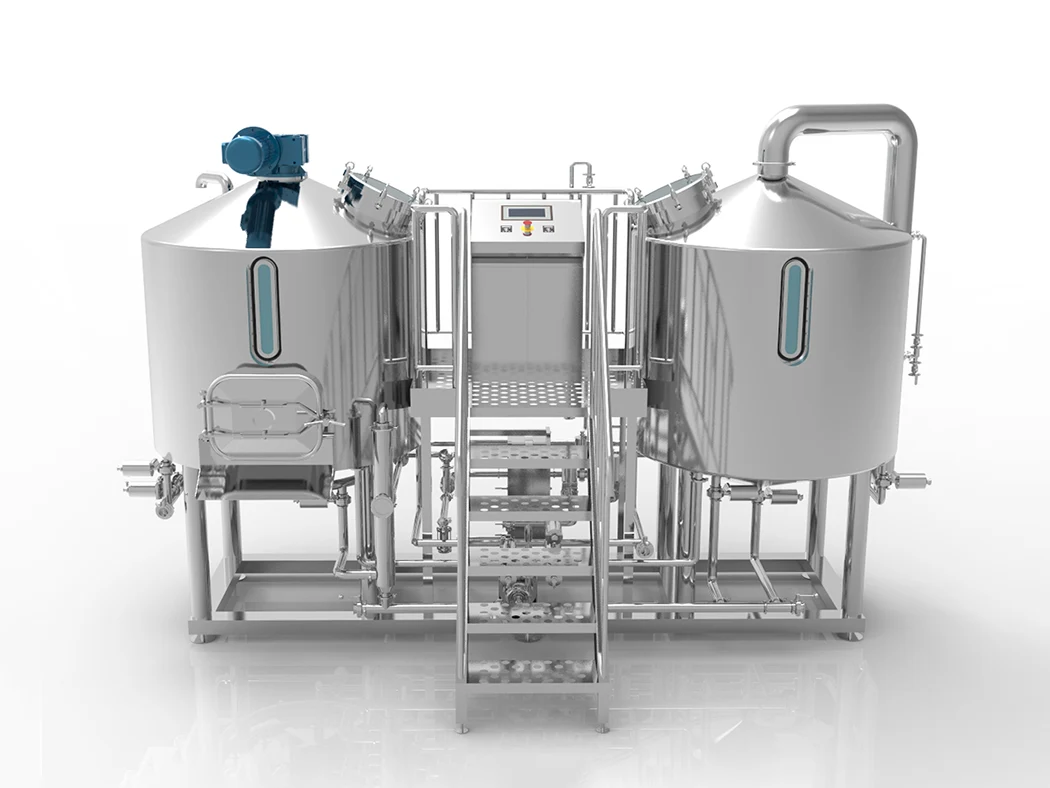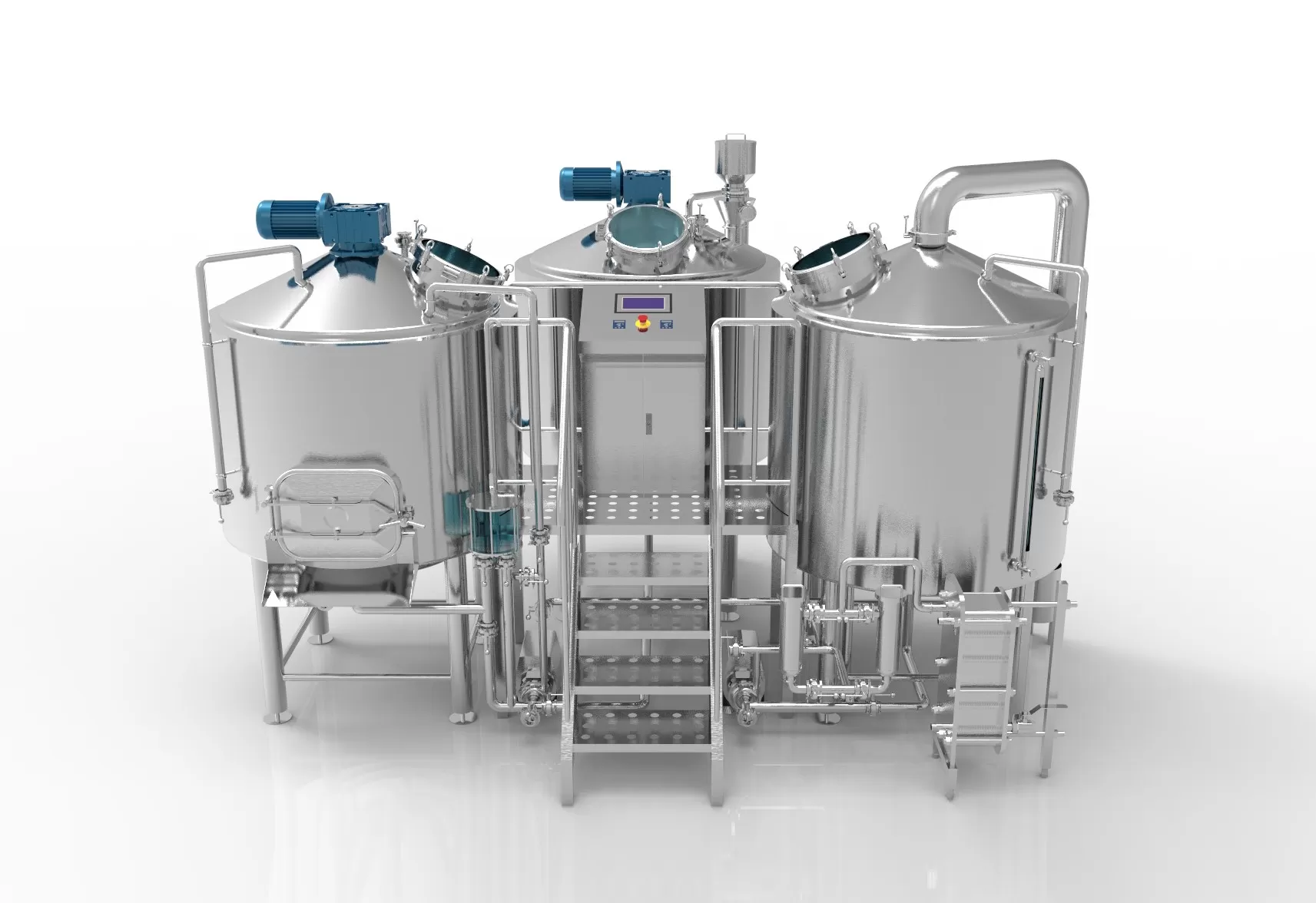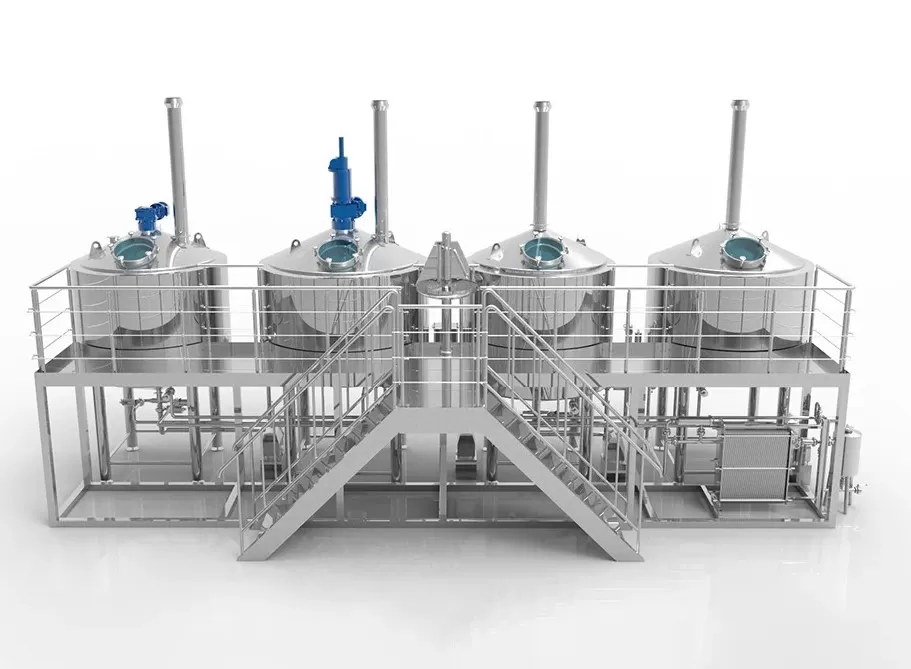What is a Bright Beer Tank?
Haben Sie genug von trübem, flachem Bier, dem der Glanz und die Klarheit fehlen, die Ihre Kunden erwarten? Haben Sie mit einem uneinheitlichen Kohlensäuregehalt zu kämpfen, der Ihr sorgfältig gebrautes Bier nicht perfekt macht? Diese häufigen Brauprobleme können Ihrer Marke schaden und Ihre Kunden enttäuschen.
Think about it: You’ve invested countless hours perfecting your recipe. You’ve carefully selected the finest ingredients. But when it comes time to serve, your beer looks hazy and tastes flat. How frustrating!
The solution? A high-quality bright beer tank (BBT) that ensures crystal-clear, perfectly carbonated beer every single time.
A bright beer tank is the final storage vessel where your beer rests after fermentation. It helps with carbonating, clarifying, and stabilizing your beer before packaging. Unlike fermentation tanks, bright tanks focus on finishing touches that make your beer market-ready.
“The right bright tank can be the difference between good beer and great beer,” says Nancy, a brewing equipment expert with 15 years of experience helping breweries optimize their processes. “It’s the final step that ensures consistency and quality.”
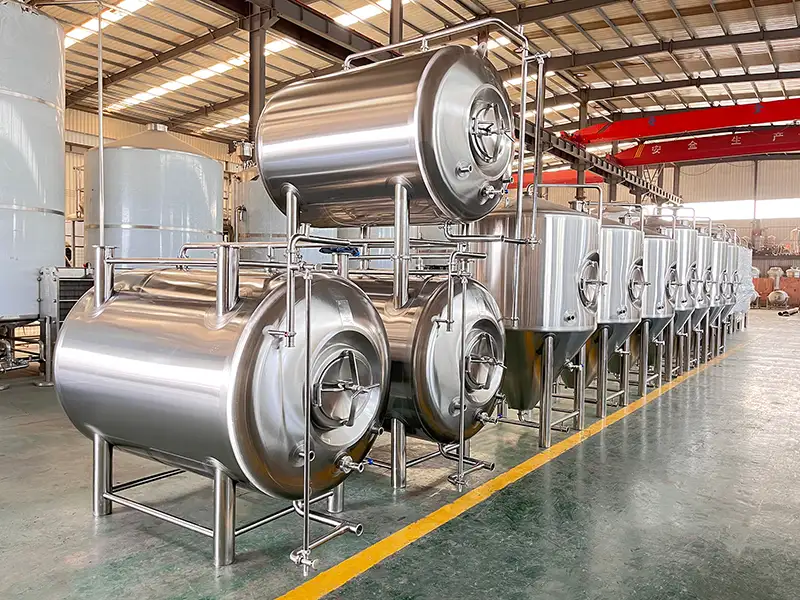
Core Functions & Components
How a Bright Beer Tank Works
The bright tank process follows three key steps:
- Carbonation injection: CO2 is added through a carbonation stone
- Sediment settling: Remaining yeast and proteins drop out
- Temperaturkontrolle: Cool temperatures maintain clarity and carbonation
For best results, brewers should aim for CO2 volumes between 2.5-2.7 and turbidity less than 1 NTU. These numbers aren’t random – they represent the sweet spot for most beer styles.
Essential Components
Every quality bright beer tank includes these key parts:
- Carbonation stone: Diffuses CO2 evenly
- Zwickel valve: Allows for sampling
- CIP spray ball: Ensures thorough cleaning
- Pressure relief gauge: Maintains safe pressure levels
The best tanks use 304/316L stainless steel with ASME certification. This isn’t just about durability – it’s about food safety and meeting industry standards.
“When we design helle Tanks at Micet, we insist on 316L stainless steel for superior corrosion resistance,” explains the production director with 13 years of experience. “It’s worth the investment for long-term reliability.”
Bright Tank vs. Fermentation Tanks
Key Differences
Many new brewers confuse bright tanks with fermentation tanks. Here’s how they differ:
| Merkmal | Gärbehälter | Heller Biertank |
|---|---|---|
| Main purpose | Primary/secondary fermentation | Final conditioning |
| Bottom design | Konisch | Flat/dished bottom |
| Druckstufe | Unter | Higher (for carbonation) |
| Temperatur | Varies by recipe | Cold (33-38°F) |
When to Use a BBT
Smart brewers use bright tanks for:
- Lagerhaltung: Cold conditioning to improve flavor
- Dry-hopped beers: Removing hop particles before packaging
- High-clarity brews: Achieving that brilliant, clear finish
As one brewery owner discovered after working with Micet’s service team: “Adding a dedicated bright tank to our setup increased our production efficiency by 25% because we could free up fermenters faster.”
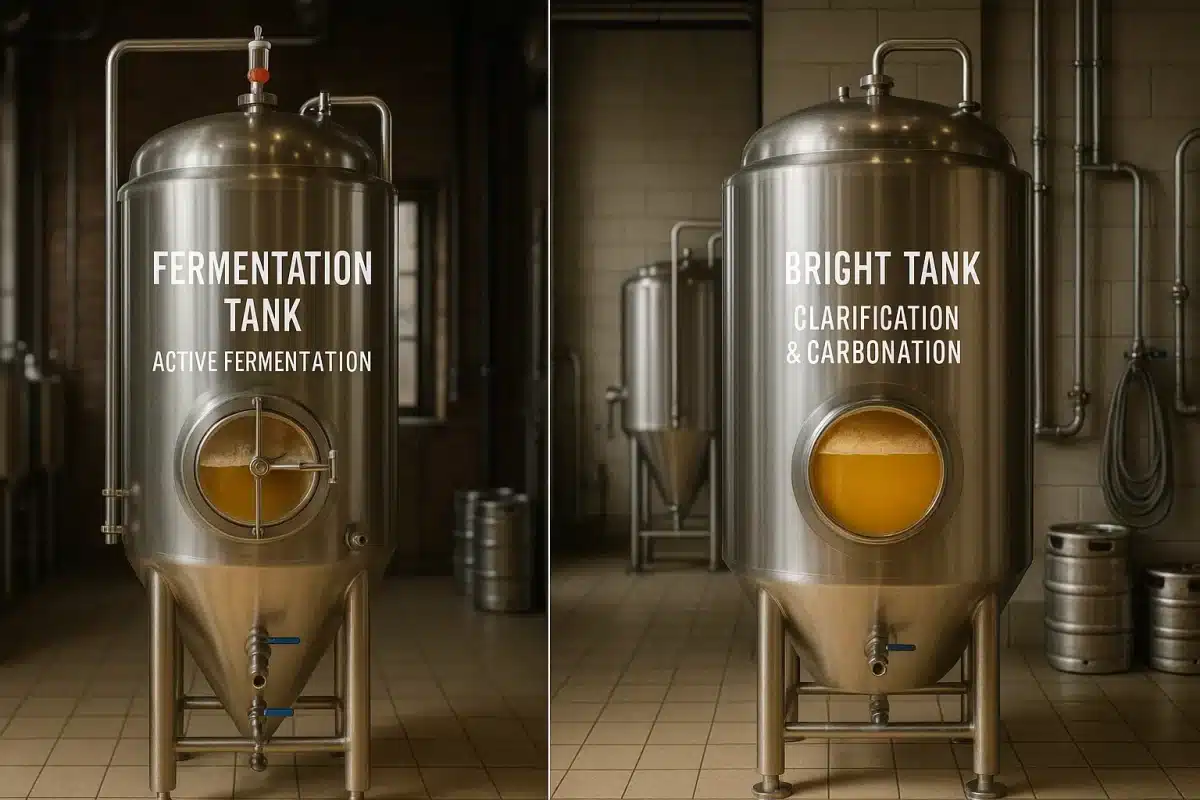
Buying Guide: Choosing the Right Bright Beer Tank
Capacity & Pressure Requirements
Buying the wrong size tank wastes money and space. Use this simple formula:
Tank capacity = Batch size × 1.2 (for headspace buffer)
For most ales and lagers, aim for pressure ratings of 15-30 PSI. This gives you flexibility for different carbonation levels.
Top 5 Features to Prioritize
- Glycol jacketing: Maintains precise temperatures
- Tri-Clamp-Beschläge: Industry standard for easy connections
- CIP compatibility: Saves time on cleaning
- NSF certification: Ensures food safety compliance
- Quality pressure gauges: Provides accurate readings
“We’ve helped set up over 1000 breweries across 86 countries,” shares a Micet quality inspector with 11 years of expertise. “The breweries that succeed long-term never skimp on these five features.”
Looking for smaller brewing solutions? Check out our Mikrobrauanlagen for specialized setups.
Cost Analysis
Tank costs vary widely based on size and features:
| Größe der Brauerei | Tank Cost (USD) | Annual Maintenance (USD) |
|---|---|---|
| Nano (1-3 BBL) | $2,000-$5,000 | $300-$500 |
| Micro (10-30 BBL) | $8,000-$20,000 | $1,000-$2,000 |
| Macro (50+ BBL) | $25,000-$50,000 | $5,000-$8,000 |
One medium-sized craft brewery reported ROI within 8 months after upgrading to a properly sized bright tank system. The boost in production efficiency and consistency paid for itself quickly.
For nano operations, our Kleinbrauereiausrüstung offers affordable bright tank solutions without sacrificing quality.
Wartung und Fehlerbehebung
CIP Best Practices
Poor cleaning leads to bad beer. Period. Follow this simple CIP process:
- Spülen: Warm water (110-120°F) for 5 minutes
- Ätzend: NaOH solution (1-2%) at 160°F for 20 minutes
- Spülen: Warm water for 5 minutes
- Säure: HNO3 solution (1%) at 120°F for 15 minutes
- Final rinse: Cold water until neutral pH
“The CIP system isn’t just about cleanliness—it’s about beer quality and tank longevity,” notes Micet’s service team leader with 22 years of brewing equipment experience. “Our tanks are designed for optimal CIP performance with strategically placed spray balls.”
Common Issues & Fixes
| Problem | Ursache | Lösung |
|---|---|---|
| Off-Aromen | Oxygen ingress | Check gaskets, use CO2 purging |
| Hazy beer | Chill haze proteins | Extend cold conditioning time |
| Lecks | Worn gaskets | Replace with appropriate food-grade gaskets |
| Low carbonation | Faulty stone | Clean or replace carbonation stone |
Industry Applications & Case Studies
Craft Brewery Success Story
A Colorado craft brewery doubled production after installing two 30-barrel bright tanks from Micet. The key changes:
- 30% faster turnaround using dual bright tanks
- Improved beer clarity (NTU <1 after 7 days)
- Consistent carbonation at 2.6 volumes of CO2
- Reduced oxygen pickup during transfers
“Before adding the bright tanks, we struggled with consistency,” the head brewer explained. “Now our beer is clearer, stays fresh longer, and customers notice the difference.”
Commercial Brewery Scaling
When scaling up, automation becomes critical. Modern bright tanks integrate with:
- Siemens PLC systems for temperature control
- Automated carbonation systems
- Pressure monitoring software
- CIP automation
One regional brewery saw production jump from 15,000 barrels to 30,000 barrels annually after upgrading to an integrated bright tank system with automation.
“The team at Micet helped us design a custom solution that fit our space constraints while maximizing efficiency,” noted the brewery’s operations manager. “Their 3-year warranty gave us peace of mind with such a big investment.”
Technical Parameters of Bright Beer Tanks
| Parameter | Typical Range/Value | Warum es wichtig ist |
|---|---|---|
| pH during conditioning | 4.0–4.5 | Affects flavor stability |
| CO2 pressure settings | 12–15 PSI | Controls carbonation level |
| Capacity range (craft) | 5–50 BBL | Matches production needs |
| Carbonation levels | 2.5–2.7 volumes | Creates proper mouthfeel |
| Material grade | 304/316L stainless | Ensures durability |
| Sediment reduction | 85–95% | Improves clarity |
| CIP cycle duration | 30–60 minutes | Maintains sanitation |
Bright Tank Impact on Beer Quality
The data shows that properly using a bright beer tank significantly improves your final product:
- Clarity: Turbidity drops from 10 NTU to less than 1 NTU within 7 days
- Shelf life: 20% longer shelf life at optimal pH (4.2)
- Wirkungsgrad: 15-25% higher efficiency in batch processing
- CO2 waste: 18% reduction with proper pressure management (15 PSI)
Brewers who invest in quality bright tanks see these improvements reflected in customer satisfaction and reduced product returns.
For breweries looking to expand beyond beer, our Brennereiausrüstung can complement your existing brewing setup.
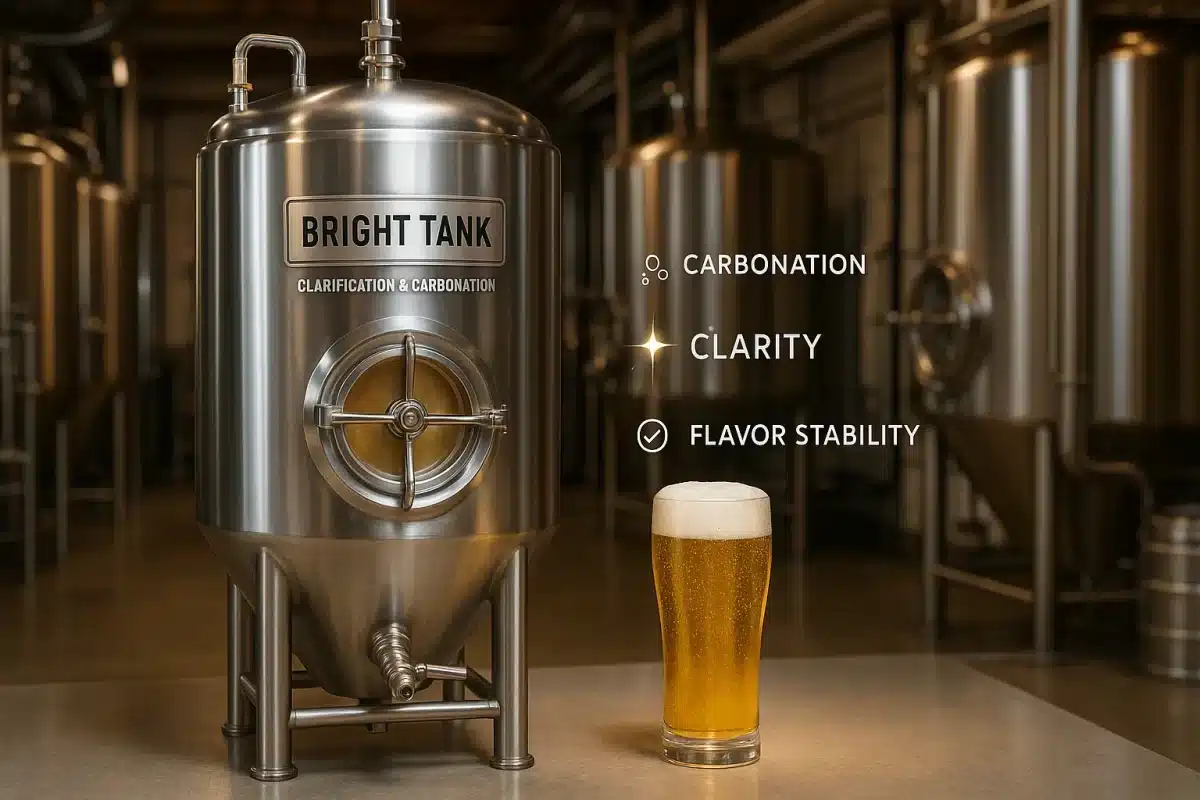
FAQs About Bright Beer Tanks
How long can beer stay in a bright tank?
Beer can remain in a bright tank for 2-4 weeks, depending on temperature and CO2 levels. Colder temperatures extend storage time.
Is there a difference between a bright tank and a brite tank?
No, these are just terminology variants referring to the same equipment. Both names describe tanks used for clarifying and carbonating beer.
Can I use a fermentation tank as a bright tank?
While possible in a pinch, dedicated bright tanks have specific pressure ratings and features for carbonation that most fermenters lack. Using the right tool for the job ensures better results.
What’s the ideal temperature for a bright tank?
Most brewers maintain 33-38°F (0.5-3.3°C) in their bright tanks. This cold temperature helps with clarity and carbon dioxide solubility.
How do I calculate the right size bright tank?
Multiply your standard batch size by 1.2 to account for headspace. For example, a 10 BBL brewing system would need a 12 BBL bright tank.
Why Bright Tanks Matter: The Bottom Line
The difference between good beer and great beer often comes down to the final conditioning stage. A quality bright beer tank:
- Improves product Konsistenz
- Enhances beer clarity and visual appeal
- Ensures proper Karbonisierung
- Extends product shelf life
- Increases brewing Effizienz
“After 15 years helping breweries around the world improve their processes, I’ve seen firsthand how the right equipment transforms beer quality,” says Micet CEO Nancy. “Bright tanks are often the missing piece that takes good breweries to greatness.”
With brewing competition fiercer than ever, can you afford to skimp on the equipment that directly impacts your final product quality? The right bright tank isn’t just an expense—it’s an investment in your brewery’s reputation and success.
Ready to take your brewing to the next level? Explore our complete Biergärbehälter and bright tank solutions designed by brewers, for brewers.
With Micet’s 3-year warranty on tanks and 12 service centers worldwide, you’ll get both quality equipment and peace of mind. Our team’s combined 60+ years of brewing industry experience ensures you’ll receive exactly what your brewery needs to succeed.

